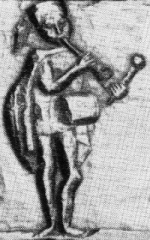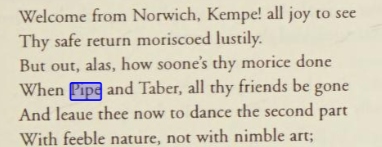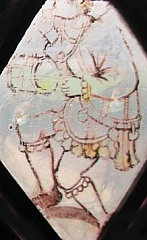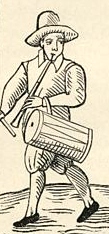England history: pipe and tabor
Cotswold morris dance
| The pipe and tabor were played for Cotswold morris dancing in England for many centuries.
By the end of Victorian times it was superceded
by the violin and then the melodeon and accordian. [This is not an exhaustive study of the morris, just some items I have come across - project manager ] |
||||
"John the piper " occurs in some Newton charters about 1346. Drayton (" Eclogue" iii.) quoted in Rush Bearing by Alfred Burton 1891 p130 |
||||
| In the records of a 1448 feast, Careawey, a harpist, and a certain John Pyper are named, alongside morris dancers and other minstrels. Goldsmiths’ Wardens’ Accounts and Court Minutes, CL, 165 The theft of instruments, including morris bells (recorded in 1515). Court of Common Council, Journal 11, CL, 324, Court of Common Council, Journal 12, CL, 421 |
||||
Morris dances that are mentioned with some regularity in the Watch records between 1477 and 1541. The Drapers’ Minutes and Records list: Burnet, William; [minstrel; Morris dancer] 1522 MUSICIANS AND COMMONERS IN LATE MEDIEVAL LONDON Simon Polson, Doctor of Philosophy, 2020 |
||||
In the Zouche Chapel, York Minster, it is recorded that there was an illustration of a This image is also mentioned here:
|
||||
1510-1625 “One of the crown jewels included a gold salt dish with moms dancers. ‘A Calendar of Early Morris Performances and References' in Amerlcan Morrls Newsletter page 19 of 36 |
||||
| 1550's
in Henley,
Oxfordshire, some “seasonal games survived …with payments made in the mid 1550s for refurbishing morris costumes, repairing the garters of bells, and for a fool and tabor-player at Whitsuntide…” |
||||
| Morris dancing played an important role in the life of the church. Individual churches paid for food and drink and the costumes of the dancers as well as giving them a payment. It fell from favour after the Elizabethan Settlement of 1560. Thereafter, tainted by association with Rome and condemned by an increasingly militant Puritanism, church performances dwindled; they became the target of Episcopal injunctions from 1571. |
||||
1577 May Day at Bradgate, Leicestershire "Then, when the merrie May Pole and alle the painted Morris-dancers, withe Tabor and Pipe, beganne ‘The Tablette Booke of Ladye Mary Keyes: Owne Sister to the Misfortunate Ladye Jane Dudlie ; in Wiche Wille be Founde a Quoted in Publications of the Folk-lore Society |
||||
 1580's Lancaster Castle 1580's Lancaster Castlewood carving, probably part of a casket |
||||
| “In 1585, John Taylor published " Drinke and Welcome," in which he mentions "the fagge-end of an old man's old will, who gave a good somme of mony to a Red-fac'd Ale-drinker who plaid upon a Pipe and Tabor, which was this : ' To make your Pipe and Tabor keepe their sound, and dye your crimson tincture more profound, There growes no better medicine on the ground” [quoted in Rush Bearing] |
||||
| There is evidence of morris dancing having been performed in Gloucestershire from the early 16th century to the present day. Throughout much of this time, the pipe and tabor has accompanied the dance. (source) |
||||
1589 Canterbury Evidence of Henry Parkes, 26, 10 May 1589 he is a musician and was hired on May Day last … to play Evidence of J Turrey, says Henry Parkes was hired about a fortnight before May Day to fiddle for Morris Dancing The National Archives CC/JQ/382/iv, Canterbury Cathedral Archives and Library |
||||
1591 Ickleton, Cambridgeshire, Diocesan Court Proceedings: Pampisford Iohannem Loughts, minstrell: “Notatur for pipeinge or playeinge before the morrice dauncers upon trinitie Sondaye, |
||||
| Terminating the performances of Elizabethan plays a morris jig was danced with an infusion of rhyming songs or speeches delivered by the clown of the theatre to the accompaniment of pipe and tabor. Jigs usually lasted for an hour. The Stationers' registers contain entries in 1595 of two jigs described respectively as Phillips's "Jig of the Slippers," and Kempe's "Jig of the Kitchen-stuff Woman." Other jigs referred to by contemporary writers are "The Jig of the Ship" and "The Jig of Garlick." |
||||
1590 Plaine Percevall, the Peace-Maker of England [quoted in Rush Bearing, by Alfred Burton 1891, p107] |
||||
|
||||
1618 poem after Kemp died, before 1608:  |
||||
1600 a play called ‘The Shoemaker's Holiday or the Gentle Craft’, Eyre announces that: Thomas Dekker (F2v , III.iii.49-50). |
||||
for other types of dance see: dance of death 18th century dance folk customs moresca |
top of page


